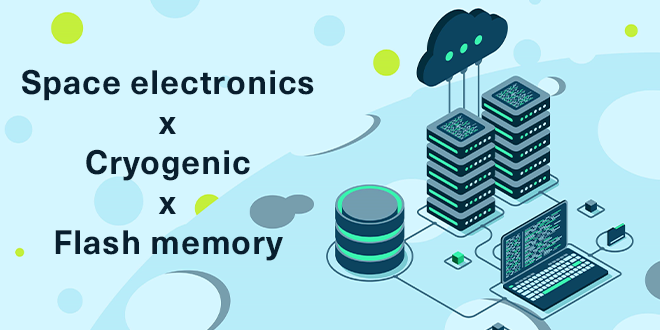Pursuing the Potential of Flash Memory for the Quantum and Space Ages
Building a Creative World through Memory Technology
September 14, 2023
Semiconductor memory has become an indispensable component of our digital society in a variety of cutting-edge technological fields. Kioxia Group is developing sustainable flash memory that can operate stably in cryogenic environments and with a longer life span than conventional flash memory, with a view to enabling its deployment in quantum computing and future aerospace applications.

Challenges of flash memory for storing and processing large amounts of data
Advances in flash memory technology
With the widespread use of AI, IoT and big data applications, large amounts of digital data are generated every day. SSDs (solid state drives) and HDDs (hard disk drives) are used in data centers and servers. SSDs are superior to HDDs in terms of data access speed, power consumption, and hardware size, and SSDs are therefore increasingly superseding HDDs. We’ve been able to increase the capacity of the flash memory used in SSDs through the “high stacking” of memory cells and “multi-level” cell technology, which increases the amount of data that can be stored in a single memory cell.
Reference link:
Growing expectations for memory that can operate in cryogenic environments
In recent years, there has also been growing demand in quantum computing and aerospace applications for memory that can operate at cryogenic temperatures (close to absolute zero, or -273.15℃). Quantum computers operate at about 10 mK (slightly above absolute zero, achieved through the utilization of liquid helium for cooling). CPUs controlling quantum computers as well as memory and storage devices must be able to operate at cryogenic temperatures. In future aerospace applications, computers and electronic equipment used in satellites, planetary probes and lunar bases will also be required to operate at these temperatures. Despite these growing expectations, there have been no reports of any cryogenic operation of flash memory in these kinds of devices at academic conferences or other events.
Kioxia Group's approach: development of sustainable flash memory capable of stable operation at cryogenic temperatures
Cryogenic operation improves storage performance
Kioxia Corporation has successfully operated 3D flash memory at 77 K (the temperature of liquid nitrogen) and demonstrated that operation under cryogenic conditions can further improve storage performance. The data retention characteristics of flash memory are improved, and read noise is significantly reduced. Furthermore, degradation resulting from repeated write/erase operations can be suppressed.
World's first demonstration of 7-bit per cell flash memory operation
The improved storage characteristics in cryogenic environments will also drive a quantum leap in multi-level technology. The highest multi-level cell flash memory currently in mass production is 4 bits per cell; however, in a world-first, Kioxia has demonstrated its ability to achieve 6 bits per cell through operation under cryogenic conditions, and 7 bits per cell by augmenting this with processing technology that enhances the characteristics of memory cells.
Reference link:
Sustainable memory technology
In the course of its latest research activities, Kioxia has demonstrated reversible 7 bit per cell operation through the use of annealing (heat treatment) to minimize the characteristic degradation in data retention performance caused by flash memory operation (Figure 1).

Joint development with partners: cryogenic cooling system
Kioxia is jointly developing a cryogenic cooling system with Nagase Techno-Engineering Co. Ltd. Memory modules are cooled by placing them on a metal plate inside a vacuum chamber (Figure 2); this can reduce the cost per bit even when cooling costs are taken into account (Figure 3).


Future prospects
The cryogenic operation of flash memory is expected to be utilized in quantum computing and future aerospace applications.
For example, in quantum computers, a significant performance improvement can be expected by deploying large-capacity memory that is able to operate in the same environment as quantum bits, i.e., under cryogenic conditions. In aerospace applications, electronic devices will be able to operate over a wide temperature range, such as on the lunar surface, and with a long operational life.
In addition, by deploying this technology, Kioxia will be able to deliver higher capacity flash memory using a different approach to conventional high stacking, and will continue the development of sustainable memory that has a longer life span than conventional memory.
Kioxia Group will continue to develop new memory technologies, aiming to realize their deployment in new fields and applications.
Message from Nagase Techno-Engineering Co., Ltd.
We have a long track record of supplying a wide range of cooling systems, including cryogenic refrigerators for superconducting applications in the energy and medical sectors, cryogenic systems for laboratories, and the cryogenic prober systems used in semiconductor development.
We are delighted to have been able to cooperate with Kioxia in this development of cooling systems for memory devices operating in cryogenic temperature environments.
We hope to continue working with Kioxia to help advance the development of new memory technologies by adopting this new approach utilizing cryogenic environments.
